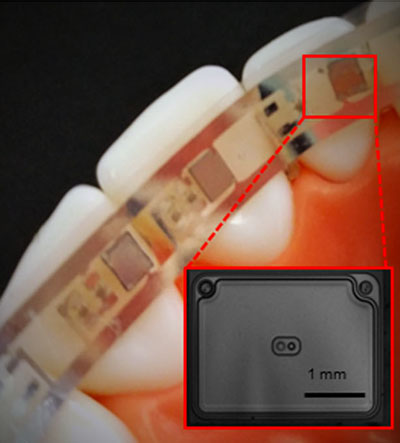| Posted: Nov 16, 2017 | |
Flexible microbattery enables smart dental braces |
|
| (Nanowerk Spotlight) Researchers have demonstrated a novel approach toward smart orthodontics based on near-infrared red light from a mechanically flexible LED powered by flexible bio-safe batteries all integrated in a single 3D-printed dental brace. | |
| As the team from King Abdullah University of Science and Technology (KAUST) demonstrates in their paper in NPJ Flexible Electronics ("Flexible and biocompatible high-performance solid-state micro-battery for implantable orthodontic system"), integration of red light therapy enhances bone regeneration, reducing overall time to wear the dental brace and unburdening users from expense. Furthermore, 3D printing allows personalized (instead of one size fits all) transparent dental brace. | |
| "Integration of electronic devices in 3D printed dental aligners, as we have demonstrated here, is a pragmatic approach towards implementing a flexible electronic technology in personalized advanced healthcare, particularly in orthodontics," Muhammad Mustafa Hussain, an Associate Professor of Electrical Engineering at KAUST, tells Nanowerk. " The next stage of our work will be to demonstrate diagnostics in the smart dental brace in which sensors are able to detect the pressure exerted by aligners on teeth. This might help orthodontists estimate the force required by aligners; thus providing both diagnostic and treatment capabilities in dental braces. " | |
 |
|
| Flexible, non-cytotoxic battery concept. Optical images of an intra-oral implantable device that relies on millimeter-sized flexible, biocompatible lithium-ion battery as a rapid powering solution. (© Nature Publishing Group) | |
| The scientific core of the team's findings is to approach flexible energy storage solutions in a way that is pragmatic, fast and well integrated with other components. A major challenge to integrate any traditional lithium-based energy storage is their toxicity. The scientists circumvented this issue by introducing non-toxic micro-scale flexible batteries to be used as on-demand power supply. | |
| Furthermore, they integrated near-infrared (NIR) capability as well as an optoelectronic system of light emitting diodes (LED) arrays in a personalized, 3D-printed semi-transparent dental brace. Of course, such a device would not have been possible without an appropriate energy storage solution. | |
| Key to this smart brace is the use of a high-performance flexible solid-state microbattery. A standalone all thin-film lithium-ion battery already can be readily thinned down to about 30 microns thickness to achieve flexibility. The team's flexing process for thin-film-based micro-batteries achieves two major objectives: 1) utilization of mature and reliable CMOS process with 90% yield and repeated electrochemical measurements on multiple devices, and 2) the ability to withstand high annealing temperatures of cathode material or soldering that are unachievable using direct film deposition on plastic substrates. | |
| "Our flexile biocompatible lithium-ion battery can be transferred on polyethylene terephthalate (PET) and interconnected via aluminum engraved interconnections to create a battery module," explains Hussain. "During testing we found that the battery module exhibits minimal strain while most of the stress is experienced by the PET film." | |
| Continuous intra-oral NIR light therapy for patients is becoming a growing necessity for accelerating the rate of the bone remodeling process. Near-infrared light can be absorbed by bone cells to stimulate the bone regeneration for faster orthodontic treatment. | |
| That's why the team integrated near-infrared LEDs with the flexible batteries and interconnected them on a soft PET substrate. The whole device is embedded in semi-transparent 3D-printed brace. | |
| To summarize, this smart dental brace relies on two main functionalities: Firstly, a customizable, personalized, and semitransparent brace, which provides required external loading to stimulate healthy rebuilding of bone structures. Secondly, a miniaturized, soft, biocompatible optoelectronic system for an intraoral (conformable on the mouth) near-infrared light therapy, which allows rapid, temporally specific control of osteogenic cell activity via targeted exposure and light sensitive proteins present in bone cells. | |
| "The combination of both strategies in one single platform provides affordable, multifunctionality dental braces," concludes Hussain. "Such capability enhances the bone regeneration significantly and reduces the overall cost and discomfort. Our future work will include integration of compliant soft-substrate-based LEDs and miniaturized ICs with enhanced wireless capability for smart gadget-based remote control for cleaning and therapy." | |
 By
Michael
Berger
– Michael is author of three books by the Royal Society of Chemistry:
Nano-Society: Pushing the Boundaries of Technology,
Nanotechnology: The Future is Tiny, and
Nanoengineering: The Skills and Tools Making Technology Invisible
Copyright ©
Nanowerk LLC
By
Michael
Berger
– Michael is author of three books by the Royal Society of Chemistry:
Nano-Society: Pushing the Boundaries of Technology,
Nanotechnology: The Future is Tiny, and
Nanoengineering: The Skills and Tools Making Technology Invisible
Copyright ©
Nanowerk LLC
|
|
|
Become a Spotlight guest author! Join our large and growing group of guest contributors. Have you just published a scientific paper or have other exciting developments to share with the nanotechnology community? Here is how to publish on nanowerk.com. |
|
